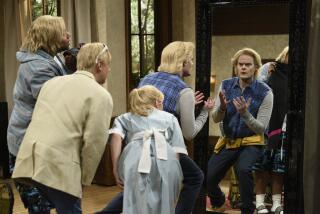Reading the Comics
- Share via
I have a confession that might surprise you and amuse my colleagues in the Department of English at Cal State Northridge. But here it is anyway: I read the comics section of the Los Angeles Times. Virtually every day. Not every comic strip, mind you, but a fair sample of them. I’ve even managed to be sucked in by some of the interminable story lines of such venerable cartoon soap operas as “Mary Worth” and “Rex Morgan, M.D.”--though I’ve disciplined myself not to look at them anymore because cartoon serials are like potato chips: You can never read just one.
On the other hand, maybe I shouldn’t worry about what my colleagues might say. With so many of their office doors adorned with choice comic strip panels, I can only conclude that I’m not alone in my habit. We could even commiserate about the decline in the quality of our lives wrought by the premature retirements of Bill Watterson and Gary Larson (oh, please, please, come back). And the whole world, it seems, has mourned the passing of Charles Schulz.
But my purpose here is not to regale you with a cook’s tour of my favorite comic strips. Rather, I wish to offer an interpretation of the cultural significance of the funny pages in today’s newspapers, an interpretation that is anything but funny and that is certainly not kids’ stuff.
To grasp the cultural meaning of the daily funnies, we have to compare them to a far more prominent and profitable source of daily entertainment: prime-time television. We can start with “Ally McBeal,” the ongoing saga of a Harvard-trained lawyer who looks great in a miniskirt and spends most of her time fantasizing about the equally glamorous men who surround her.
Or take “Buffy, the Vampire Slayer.” Buffy, who also looks good in a miniskirt, is, by day, a mild- mannered schoolgirl who wants only to be popular but who by night must save the world from the supernatural beasties that seem to hover around our metaphysical horizons.
And then there’s “Roswell”: more teens, some of whom look good in miniskirts, saving us all from aliens. You say you want something more realistic? Try “Two Guys and a Girl,” which features a medical student who, at least in some early episodes, delivers pizza, and in all of them chases women who look good in miniskirts, and his architect roommate who has never drawn a blueprint.
Is a pattern emerging here? I think so. Ever since the smash successes of “Beverly Hills, 90210,” “Melrose Place,” “The X-Files” and “Friends,” prime-time television has increasingly been turned over to teen-and-twenty-something viewers for whom ordinary existence seems to fall far short of their fantasies. So in prime-time fantasyland, roommates don’t just share the rent: They share one anothers’ lives and loves. Students don’t seem to need to study, and employees never really have to work. Plenty of supernatural creatures are on hand to relieve the tedium of daily life. And easy sex is always available for everyone who wants it.
Now, compare this to the daily comics. Consider Lynn Johnston’s “For Better Or For Worse,” whose lead character, Elly, copes with such problems as the death of her mother, menopause and temporary unemployment. In a sequence that her readers found particularly poignant, Johnston related the bittersweet loss of Elly’s dog Farley. As her children grow up and move out into the world, Elly adjusts with good humor and perseverance and love. She thinks about what time is doing to her body but never gets obsessed about it. In short, she faces her world, and the time that is always ticking away in it, as we all must do if we are to cope with the burdens of real life.
A number of other strips present equally ordinary, and aging, characters: “Crankshaft,” “Jump Start,” and, more comically, “Baby Blues.” “Real Life Adventures,” for its part, manages to capture with astonishing precision the little screwups we get ourselves into every day when, say, we try to fix our own plumbing or forget to measure the width of that new sofa that we can’t fit through the front door.
In the funny pages, then, we can find a not-so-funny picture of the real world in which we live, a place in which time passes and simply surviving can be heroic. Those television shows that do attempt to be realistic (like “ER” and “NYPD Blue”) still fall short of the sheer ordinariness of the comics in their need to present highly dramatic story lines featuring dramatically glamorous professions. Cops, lawyers and doctors fill the screen; the comics are filled with bus drivers, secretaries and dentists.
That’s why I like the funnies. When so much of American popular culture is devoted to youthful fantasies of wealth, glamour, excitement and sex appeal, we can find in the daily comics, of all places, a bastion of normalcy. By seeing ordinary life represented we can better appreciate the quiet, unglamorous heroism of making it from day to day in the real world. That isn’t something that the rest of American popular culture is encouraging us to do, so the comics fill an important cultural gap. Paradoxically, it is in cartoons that we may find real people, real problems and real lives. Now that’s what I call adult entertainment.
More to Read
Sign up for The Wild
We’ll help you find the best places to hike, bike and run, as well as the perfect silent spots for meditation and yoga.
You may occasionally receive promotional content from the Los Angeles Times.






